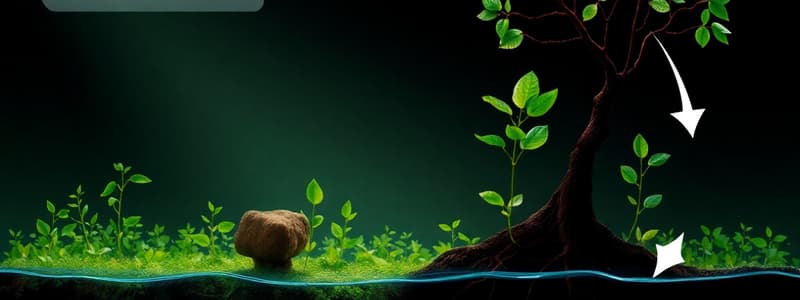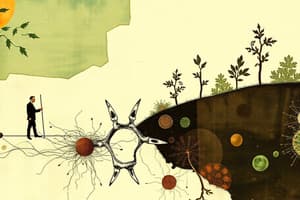Podcast
Questions and Answers
The lithosphere exclusively consists of gaseous carbon compounds.
The lithosphere exclusively consists of gaseous carbon compounds.
False (B)
Photosynthesis results in the release of carbon dioxide into the atmosphere.
Photosynthesis results in the release of carbon dioxide into the atmosphere.
False (B)
Carbon cycles only occur in the biosphere and have no implications for the atmosphere.
Carbon cycles only occur in the biosphere and have no implications for the atmosphere.
False (B)
Volcanic eruptions contribute to the carbon cycle by absorbing atmospheric carbon dioxide.
Volcanic eruptions contribute to the carbon cycle by absorbing atmospheric carbon dioxide.
Decomposition of organic matter plays a role in releasing carbon back into the soil.
Decomposition of organic matter plays a role in releasing carbon back into the soil.
Human activities have no effect on the carbon cycle.
Human activities have no effect on the carbon cycle.
Carbonate rocks form through the incorporation of carbon from living organisms over a short period.
Carbonate rocks form through the incorporation of carbon from living organisms over a short period.
The hydrosphere is linked to the carbon cycle through the dissolution of carbon dioxide in water bodies.
The hydrosphere is linked to the carbon cycle through the dissolution of carbon dioxide in water bodies.
Flashcards are hidden until you start studying
Study Notes
The Carbon Cycle
- The carbon cycle is a continuous process that involves the movement of carbon between Earth's different reservoirs.
- These reservoirs include the atmosphere, biosphere, lithosphere, and hydrosphere.
- The atmosphere contains carbon dioxide as a primary component.
- The biosphere encompasses all living organisms, where carbon is exchanged through processes such as photosynthesis and respiration.
- The lithosphere includes rocks, soils, and fossil fuels, which contain carbon from once-living organisms.
- The hydrosphere, although not explicitly labelled, is also included in the cycle, with carbon exchange occurring within the water bodies.
- Carbon is released into the atmosphere through volcanic eruptions.
- Photosynthesis involves plants absorbing carbon dioxide from the atmosphere to create organic compounds.
- Respiration releases carbon dioxide back into the atmosphere.
- Decomposition breaks down organic matter, releasing carbon back into the soil.
- Carbon from once-living organisms is transformed over millions of years into fossil fuels in the lithosphere.
- Human activity releases carbon stored in fossil fuels into the atmosphere as carbon dioxide when fossil fuels are burned.
- The formation of carbonate rocks incorporates carbon.
- Carbon dioxide from the atmosphere can dissolve into the oceans.
- The carbon cycle is a complex natural cycle, with various processes contributing to the movement of carbon between different reservoirs.
Studying That Suits You
Use AI to generate personalized quizzes and flashcards to suit your learning preferences.




